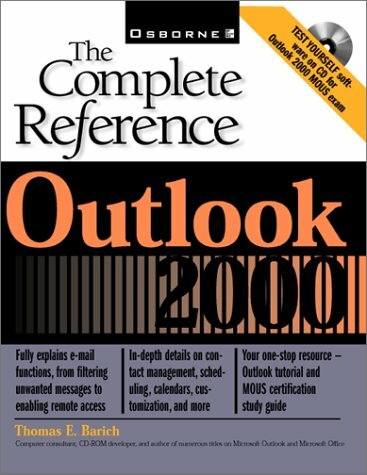Outlook 2000: The Complete Reference
This is a great guide for beginners while experienced users can learn some new tricks.
by David A Williams
7/25/2001 --
 |
 |
 |


| Title |
|
 |
|
Outlook 2000: The Complete Reference |
 |
| Authors |
|
|
|
Thomas E Barich |
 |
| Publisher |
|
|
|
Osborne McGraw-Hill |
 |
| Publication Date |
|
|
|
August, 2000 |
 |
| ISBN |
|
|
|
0-07-212436-9 |
 |
| Price |
|
|
|
$39.99 (U.S) |
 |
| Pros |
|
|
|
The section on VBA is excellent and encourages experimentation. |
 |
| Cons |
|
|
|
I would have liked more coverage of creating custom forms for use within the application. |
 |
| Verdict |
|
|
|
I would highly recommend this book and very much enjoyed reading it. If you are looking for a book that can be used as an exam study guide as well as a reference book, then this one is certainly worth a look! |
|
|
|
|
|
|
|
|
|
|
|
|
 |
Outlook 2000: The Complete Reference is an authoritative guide to the basic and advanced features of Microsoft Outlook 2000 (including the Visual Basic for Applications language, which can be utilized to customize Outlook beyond what is possible with the usual toolbars and menus). Many of the book’s 25 chapters feature tables at the end listing the MOUS (Microsoft Office User Specialist) objectives covered in the chapter. The Appendix section also features a list of the MOUS objectives covered in the book and a guide to using the Personal Testing Center CD included with the book.
The reference draws on sidebars, screen shots and tips to guide the reader. The book is VERY well illustrated throughout, using a profusion of screenshots from the actual application to better illustrate ideas and concepts, which makes it easier for readers to understand what is being discussed. Throughout the chapters, Tips, Notes, and Cautions provide additional information and help to spotlight potential pitfalls. An enclosed CD-ROM includes a Personal Testing Center providing 65 multiple-choice questions drawn from the book's contents. The software has two different testing options: Practice and Final. The Practice exams consist of a series of 65 multiple-choice questions. During the Practice Exam, an answer icon is available and you may view the answers as needed. An Answers in Depth link in the Practice Exam provides helpful additional information. The Final offers a timed-exam setting with 65 multiple-choice questions for each exam. You can take an entire exam at one sitting or can choose to exit the exam at any point. Whether you take the complete test, or just a portion of it, you can see your test results grade and assess your knowledge levels. You will see your score for individual MOUS Objective Skill-sets and for the entire test to show where you might need specific refresher work.
This comprehensive text would make an excellent book for someone who has little or no experience with Outlook 2000 and would like to have a wide-ranging reference book. An experienced user can also learn a lot from it (I personally have been using Outlook 2000 daily since it was first released, and before that Outlook 98, and the book taught me quite a number of things. It also got me interested in doing some experimentation with VBA, and that was a lot of fun!). The CD-ROM that accompanies the book is well designed and a good review for the MOUS exam.
While there were few bad aspects of the book, some did stand out. First, the section on designing and creating custom forms for use within Outlook 2000 was too short in my opinion. Its 25 pages is not enough to teach a beginner how to do much with custom forms. Second, the section on using the Notes feature of Outlook did not need to be 16 pages long; there really isn’t that much you can do to configure this feature. These minor issues aside, I highly recommend this book and very much enjoyed reading it. If you are looking for a book that can be used as an exam study guide as well as a reference book, then this book is certainly worth a look!
For additional information on MOUS (Microsoft Office User Specialist) certification check out the CertCities MOUS FAQ (Frequently Asked Questions) at: http://certcities.com/certs/mous/faq/default.asp#1
Have you read this book? Let us know what you think! Rate it below or visit our Forums.
David Williams is an Information Systems Network Analyst for a large healthcare organization. He is the sole technical support person for over 250 users. His experience includes Novell NetWare, Windows 9x, Windows NT/2000, SQL Server, Exchange 5.5, Windows CE, and Office 97/2000. He is currently working on implementing Citrix MetaFrame, a secure VPN system, and an intranet for his organization. His interests outside of work include Linux, Visual Basic, and spending time with his family. David plans to begin MCSE & A+ studies this summer if he can find some time!
|

 Book Review Article
Book Review Article
